Abstract
The cylindroid describes the exact distribution of the screw axes of the general two-system of screws. For the general three-system, this article introduces the surface on which lies the position vector endpoints of its screw axes, and then develops the finite distribution zone in which they most densely distribute. In particular, this paper explores the inner structure of the zone by partitioning the general three-system into two-subsystems, and then reveals the principle of constructing the distribution space of the general three-system by that of the general two-system in Euclidean three-space. In pursuit of a generalized decomposition method, we propose the varying-pitch ruled surface carrying the screws whose pitch value continuously varies according to any desired function rule, based on the pitch-hyperboloid carrying all the equal-pitch screws. This investigation provides some useful guides for the axode planning and then the motion planning of three degree-of-freedom parallel mechanisms.
Keywords:
axode; cylindroid; pitch-hyperboloid; principal screw; two-subsystem; general three-system 1. Introduction
When planning the motion of lower-mobility parallel mechanisms, we may need to plan the distribution of a serial of instantaneous screw axes (ISAs) of the moving platform (i.e., to plan its axode) in the reference frame of the mechanisms for some special application scenarios. However, the rotational axes of lower-mobility parallel mechanisms cannot be chosen arbitrarily in the reference frame of the mechanisms [1]. For the above fact accounts the corresponding lower-order screw system (the order of screw system is no more than three) [2] whose screw axes distribute in a finite zone of Euclidean three-space. So, this finite zone must be taken into consideration when we plan the axode of lower-mobility parallel mechanisms.
Although Ball and Hunt [3,4,5] have revealed that the equal-pitch screws of the general three-system lie on a pitch-hyperboloid, there have been few papers providing a deeper and more comprehensive study on the finite zone and the distribution characteristics of the screw axes of the general three-system in Euclidean three-space. To provide some useful guides for the axode planning of three degree-of-freedom parallel mechanisms, we originally present the mathematical expressions of the finite distribution zone of the screw axes of the general three-system by deriving the striction points on a screw axis when it is infinitely close to its surrounding screw axes in its infinitesimal neighborhood space. Furthermore, we originally reveal the distribution regularity of the screw axes of the general three-system by partitioning them into two-subsystems [6].
For the convenience of analysis of the distribution characteristics of the general three-system, we compute and derive it in its principal frame [4,7] in which its three principal screws attain their simplest forms because they are mutually and orthogonally concurrent at the origin of the principal frame and because their screw axes are along the x-, y-, and z-axes of the principal frame, respectively. When planning the axode of lower-mobility parallel mechanisms, we need to transform the distribution zone to the reference frame of mechanisms. So, identifying the principal screws of a screw system when a set of general basis screws has been provided is a key issue in axode planning. This problem has been reduced to an eigenproblem by Parkin [8] (1990), Tsai [9] (1993), Parkin [10] (1997), Rico [11] (1998), Bandyopadhyay [12] (2004), Bandyopadhyay [13] (2009), and Zhao [14] (2009). In particular, Zhang [15] (1998) proposed an algebraic method computing the principal screws of three-systems according to the relationship between two-systems and three-systems. Fang [16] (1998) obtained the principal screws of three-systems by employing the conical section degenerating theory. Bandyopadhyay [13] pointed out that the solution of the generalized eigenproblem gives rise to the extreme values of the pitch by differentiating the expression of the pitch and arriving at the identical equation with the eigenproblem.
On the distribution of screw axes of the screw system, Huang [17] discussed the correspondence between the finite screw system and projective space. Inspired by the one-to-one mapping relationship [3] between the points on a unit circle and the screws within a two-system, Zlatanov [6] developed the one-to-one mapping between the points on a unit sphere and the screws within a three-system. Study’s map [18] clarifies there is a one-to-one correspondence between oriented straight lines in Euclidean three-space and the dual points on the surface of a dual unit sphere in dual space. Hence, a differential curve on the sphere corresponds to a ruled surface in line space.
Since the above references study the distribution of screw axes in abstract spaces, it is hard to apply them to axode planning in Euclidean three-space. To develop intuitive and visual methods of axode planning, we especially study the distribution regularity of the screw axes of the general three-system in Euclidean three-space. Furthermore, to build a bridge between axode planning and the motion planning of parallel mechanisms, we have developed a kinematic model of screw rolling between fixed and moving axodes [19,20], which solves the problem, “Given a pair of fixed and moving axodes, how to reproduce the associated continuous rigid motion?” For the distribution zone of the screw axes of higher-order screw systems, perhaps it can be decomposed into that of lower-order screw systems, as Chen [2] has decomposed the four-, five-, and six-systems into the direct sums of several two- and three-systems by the decomposition of the positive semidefinite (PSD) method.
The advances of screw theory in mechanisms are briefly listed here. Toscano [21] developed the kinetostatic model for HRs based on the screw theory. Zhao [22] proved that the time derivative of the twist is a screw and revealed that its physical meaning is the rigid-body acceleration. Sharafian [23] enhanced the joint-based method to a new version by resorting to reciprocal screws, and introduced the constraint forces and moments distribution indices. Gallardo [24] carried out the kinematic and dynamic analyses of the 2 (3-RPS) series-parallel manipulator by employing the theory of screws and the principle of virtual work. Fan [25] proposed a novel concept of a virtual screw that is formulated by a combination of virtual angular velocity and virtual linear velocity. Bu [26] developed a novel metric based on the geometric average normalized volume spanned by weighted screws to measure the distance from the current configuration to a singular configuration. Gallardo [27] obtained the input–output equations of velocity and acceleration of the 5-RPUR parallel mechanism by resorting to reciprocal screws.
The remainder of this article is organized as follows. Section 2 discusses the distribution of the position vector endpoints of the screw axes of the general three-system. Since the position endpoints are the particular case of the striction points on the screw axis, Section 3 studies the distribution of the striction points of the screw axes. The above two sections exactly describe the finite distribution zone of screw axes of the general three-system in Euclidean three-space. To reveal the inner structure of this finite zone, Section 4 decomposes the general three-system into two-subsystems and presents the detailed distribution regularity of cylindroids fulfilling the finite zone by three theorems. In pursuit of a generalized decomposition method, Section 5 proposes the varying-pitch ruled surface based on the pitch-hyperboloid. A numerical example of the 3-RPS pyramid mechanism is presented for the application of the concept ‘the densest distribution zone’ in Section 6.
2. Distribution Surface of Position Vector Endpoints of Screw Axes
In this section, we mainly discuss the positions of the screw axes of the general three-system. The general three-system of screws was firstly proposed by Hunt [4] when he classified the screw systems by the pitch values of their principal screws. In the principal frame, three principal screws of general three-systems can be expressed, respectively, as:
in the form of unit Plücker coordinates, where the superscript p represents principal screws. Without a loss of generality, we take the three principal pitches as because they are mutually distinct and are finite real numbers. Consequently, any screw within this screw system has the form
where the coefficients and are both real numbers.
Remark:
Thescrews represented by the equation are collinear, but have opposite directions with those represented by Equation(2), respectively. Since they are mirror images, they have the same distribution characteristics in Euclidean three-space. So, we only confine attention to Equation(2) in this paper.
Setting the primary part of and the dual part of , the pitch of has the form
We make a segment from the origin O of the principal frame to the point P on the axis of . For the uniqueness of the position representation of the screw , P is the nearest point to the origin O among the points on the axis of . In other words, the segment is perpendicular to the axis of . The vector is defined as the position vector of the screw with respect to the principal frame and has the form
The perpendicular foot P is defined as the position vector endpoint of the screw , with respect to the principal frame, in which P with the coordinates has the following parametric equations in terms of the coefficients and :
In the above equations, dividing equation x by equation y and equation z, respectively, and rearranging, yields
Substituting the above expressions of and into equation y of Equation (5) and rearranging yields
The above equation is simply the expression of the surface proposed by Hunt [28]. For an insight into the inner structure of this surface, it is plotted in Figure 1 by Equation (5) when we set , , and , and set the coefficients and as the two primary variables.
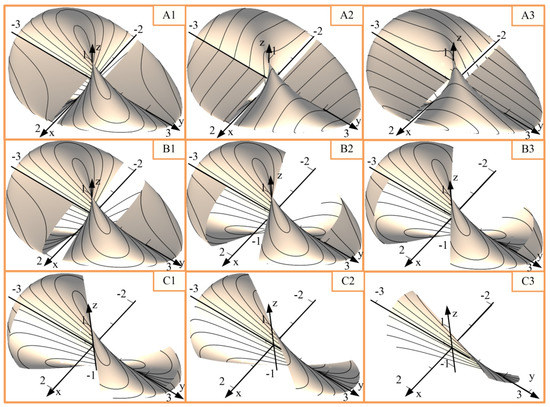
Figure 1.
The contour lines and growth process of surface .
The curves in Figure 1(A1–A3) are the contour lines of the surface perpendicular to the z-, y-, and x-axes of the principal frame, respectively. The primary variables and both continuously take values in the interval . The surface grows up from a patch of surface to a semi-closed surface with four cavity structures, as shown in Figure 1(C3,C2,C1,B3,B2,B1,A3) when the range parameter d takes the values 0.5, 1, 1.5, 2, 3, 8, and 30 in turn, respectively. When the pair of primary variables takes the pair of values and , the coordinate y in Equation (5) obtains its two extreme values and , respectively. Similarly, coordinate z in Equation (5) obtains the two extreme values and when the pair of primary variables takes the pair of values and , respectively. So, the cavity structures begin to appear when d = 1, as shown in the Figure 1(C2). In particular, since coordinate x in Equation (5) has no extreme values, the four cavity structures infinitely approach the x-axis of the principal frame, but will never be close even though the primary variables and both tend to positive or negative infinity. The surface describes the exact distribution of the position of the screw axes in Euclidean three-space.
3. Densest Distribution Zone of Screw Axes
In this section, we will derive the expression of the finite distribution zone and then reveal that the position vector endpoint is the particular case of the striction points on the axis of .
When two lines lying on a ruled surface infinitely approach each other, the two endpoints of their common perpendicular segment infinitely tend to a limit point. This limit point is called a striction point of the ruled surface. Analogously, every one of the screw axes of a general three-system will get striction points when it is infinitely close to its surrounding screw axes in all directions in its infinitesimal neighborhood space. So, the striction points of the general three-system constitute a finite striction zone. According to its definition, the screw axes all pass through this zone, and they most densely distribute in this zone. Therefore, we define this finite striction zone as the densest distribution zone of the general three-system. In the following lines, we will derive the parametric equation of the densest distribution zone.
Setting as the position vector of the screw , its axis has the following Plücker coordinates:
where is the unit vector. Without a loss of generality, the axis of another screw, , which is just in the infinitesimal neighborhood space of the screw , is denoted by:
The relative location between and is shown in Figure 2.
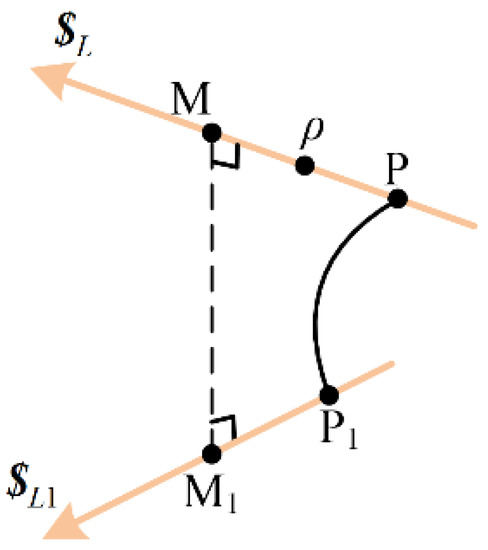
Figure 2.
Relative locations of the two neighboring screw axes.
As seen in Figure 2, is the screw axes’ common perpendicular segment. P and are their respective position vector endpoints, and is a striction point generated by and when they are infinitely close to each other. According to Equations (1–31) of [29], the point has the form
Considering , , , and are the vector functions of the two variables in and , we set
where and are the increments of the variables and , respectively. According to Taylor’s formula for functions of two variables, we have
where and are the remainder vectors of and , respectively, which both consist of higher-order vector derivatives and mixed derivatives, and their coefficients are all the infinitesimal amounts of more higher-order than and when they infinitely tend to zero. By setting
Equation (12) can be rewritten as
Substituting Equation (14) into Equation (10) yields
In Euclidean two-space endowed with the Cartesian coordinate system , when point infinitely tends to point , i.e., and both get near to zero, moves along the moving segment toward and then it moves along toward , i.e., point infinitely tends to point and then tends to striction point in the principal frame of the general three-system. Consequently, taking the limitation of Equation (15) when and both infinitely get near to zero, we have:
provided the limit exists, where
In particular, we introduce the function , which represents an arbitrary curve in plane of the Cartesian coordinate system , for that the point can arbitrarily tend to the fixed point when and both get near to zero. Correspondingly, can be arbitrarily and infinitely close to in its infinitesimal neighborhood space in the principal frame of the general three-system. Substituting Equation (17) into Equation (16) will degenerate it into the limit of the vector function of one variable as follows:
Since is a unit vector, we have . So, the above equation reduces to
For the compactness of the following formulas, we set , , , and without a loss of generality. Although Equation (19) is just the formula of the striction point of ruled surfaces, it can be used to derive the striction points of the general three-system. Substituting , , , and k into Equation (19) and rearranging lead to
where
is defined as the distribution coefficient of the striction points within the general three-system because it involves the three primary variables , , and k, and the two parametric variables e and g. In order to analyze the distribution range of the striction points on the axis of , we set , , e, and g as the parametric variables and k as the primary variable taking values in the interval . According to Equation (21), when the point tends to the point in different directions, i.e., k takes different values, we will get different striction points on the screw axis , i.e., the limit of Equation (16) does not exist in general cases. Setting yields
This means that there exist two directions along which the screw is infinitely close to its infinitesimal neighboring screws, generating two limit points which are its position vector endpoints. In particular, when and , substituting them into Equation (21) and setting yields . When and , substituting them into Equation (21) and setting yields . When and , substituting them into Equation (21) and setting yields or .
Remark:
The screwsare defined as the singular screws which always receive a unique striction point (i.e., their position vector endpoint), whatever values k takes. So, the limit of Equation (16) exists for these singular screws.
When
attains its two extreme values and as follows:
where stands for and , which are associated with the symbol “” and the symbol “” in the symbol “”, respectively. Setting and , and setting and as the primary variables, we can get the surface of and in the Cartesian coordinate system , as shown in Figure 3.
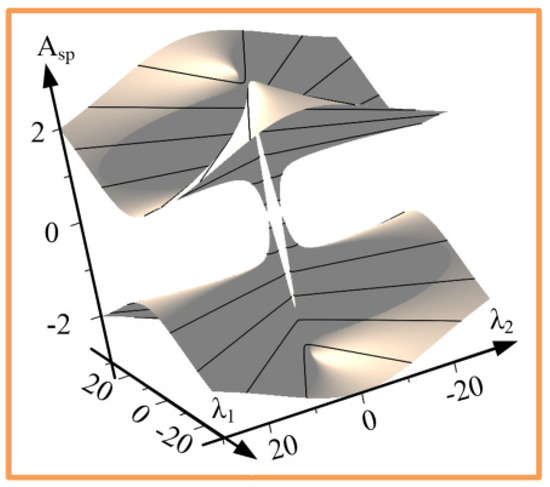
Figure 3.
The surface of distribution coefficient extreme values.
As seen in Figure 3, the curves on the surfaces are their contour lines. Equations (24) and (20) illustrate that when k takes values in the interval , striction points on every screw axis of the general three-system symmetrically distribute on both sides of the position vector endpoint P, as shown in Figure 4.
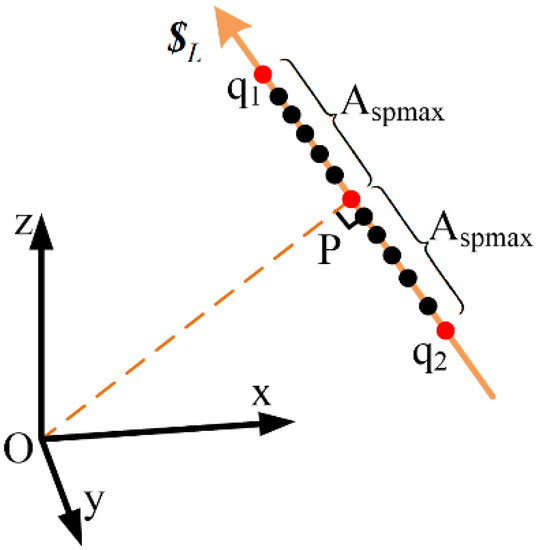
Figure 4.
The distribution of striction points on a screw axis.
As seen in Figure 4, and are defined as the top- and bottom-end striction points, respectively. So far, we can formulate the densest distribution zone of the general three-system as:
where is a three-dimensional vector function of three variables in , and v. The variable v partitions the densest distribution zone into striction point surfaces. Among these surfaces, there are three important surfaces. When , holds. We define the position vector endpoint P as the centric striction point. So, the parametric surface is also called the centric striction point surface (the surface ). Clearly, the position vector endpoint P is a particular case of the striction points. When ,
We define the parametric surface as the top-end striction point surface. When ,
We define the parametric surface as the bottom-end striction point surface. The above two parametric surfaces constitute the boundary surface of the densest distribution zone. Their parametric equations have the form
where stands for and , which are associated with the symbol “” and the symbol “”, respectively, in the symbol “”.
By the procedure of the surface evolving into the boundary surface of the densest distribution zone, we have an insight into its inner structure. In Equation (25), setting and and setting the primary variables and , both continuously taking values in the interval yield the evolving procedure as shown in the Figure 5(E1–E3,D1–D3,C1–C3,B1–B3,A1–A3), when v takes the values 0, ±0.3, ±0.5, ±0.8, and ±1, respectively. The curves on the surfaces are their contour lines.
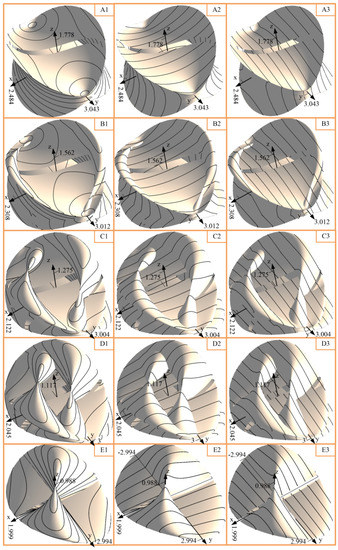
Figure 5.
The evolutionary process of the surface to the boundary surface.
To compare the relative location of the five evolutionary surfaces in Figure 5, we set the primary variables and to take values in the interval and the range parameter d to take the values 0.3, 0.5, 0.8, 1, 1.3, 1.6, 2, 2.5, 3, 6, 12, and 24 in turn, respectively. The growing up process of the five evolutionary surfaces is shown in Figure 6.
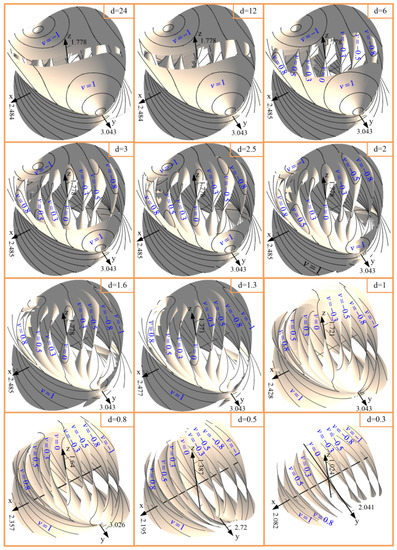
Figure 6.
The relative location of the five evolutionary surfaces.
From Figure 6, we know that the evolutionary surface associated with a bigger absolute value of v (in blue) enfolds the one associated with a smaller absolute value of v (in blue). In other words, top- and bottom-end striction point surfaces are indeed the boundary of the densest distribution zone. From the above discussion follows at once an important proposition: the striction curve of the ruled surface, which consists of arbitrary screw axes of the general three-system, must be located inside the densest distribution zone. Figure 6 describes the inner structure of the densest distribution zone in detail.
The boundary surface of the densest distribution zone of the general three-system is our original contribution. Its beauteous details are shown in Figure 7 by four close-up views. Figure 7A,B are the top-end striction point surfaces. Figure 7C,D are the bottom-end striction point surfaces.
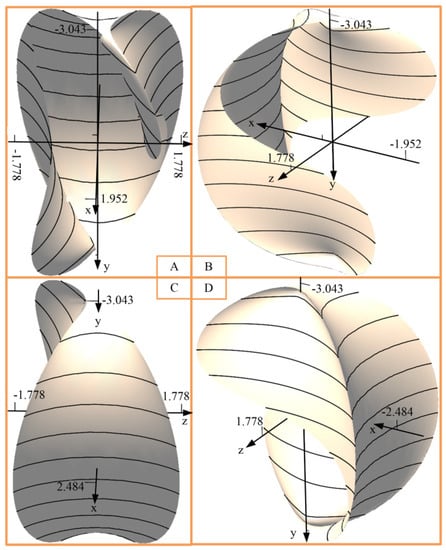
Figure 7.
The top- and bottom-end striction point surfaces.
4. Distribution Regularity of the Two-Subsystems of the General Three-System
The above two sections discuss the densest distribution zone of the screw axes of the general three-system in Euclidean three-space and decompose this zone into striction point surfaces by the primary variable v in Equation (25) to explore its inner structure. In this section, we attempt to establish the relationship between this zone and the cylindroids.
Equation (2) maps the screws within a general three-system to the points on the plane. These points can be partitioned into straight lines (a family of straight lines). Clearly, every straight line corresponds to a two-subsystem [6] of the general three-system, whose screw axes lie on a two-subsystem cylindroid (TC), as shown in Figure 8. In other words, the distribution zone of the general three-system can be partitioned into cylindroids.
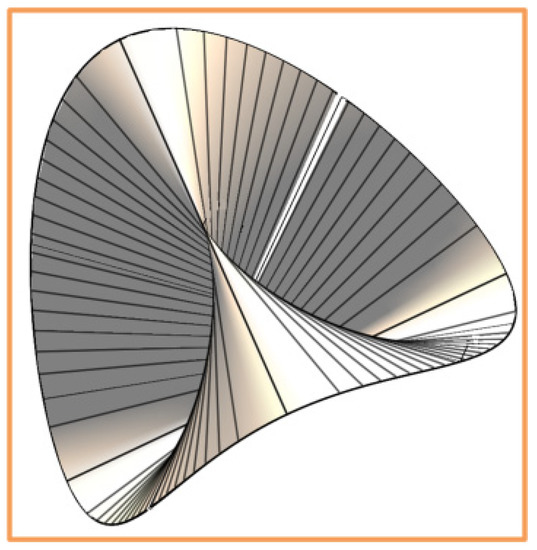
Figure 8.
The two-subsystem cylindroid.
Remark:
A partitioning method corresponds to a family of two-subsystems which consists oftwo-subsystems, and then to a family of straight lines in theplane. Any family of straight lines in theplane can be expressed as
where the slope k, primary variable, and intercept c are real numbers and take values in the interval. So, the parameter k essentially determines thepartitioning methods of the general three-system intotwo-subsystems. When the partition method has been given, the parameter c taking values in the intervalwill generate the two-subsystems of this family of two-subsystems. In a two-subsystem, the parametertaking values in the intervalwill generate thescrews.
In order to decompose the densest distribution zone into cylindroids, we establish the relationship between the cylindroid and the three parameters , c, and k in theorems 1, 2, and 3, respectively. In Theorem 1, k and c are set as the parametric variables and is set as the primary variable.
Theorem 1.
On a certain cylindroid lie thescrews of a general three-system associated with thepoints on any straight line of theplane, while on two planar pencils lie those associated with thepoints on the two exceptional straight linesand, respectively.
Proof.
Substituting Equation (29) into Equation (2) and rearranging lead to the unit Plücker coordinate of any screw within this two-subsystem, as follows:
When the primary variable is , the screw axis of traces a ruled surface whose striction curve has the following parametric equation:
From Equation (31), we know that when
The striction curve attains its two extreme endpoints and , respectively, in the principal frame, and stands for and , which are associated with the symbol “” and the symbol “” in the symbol “”, respectively. Setting the length of the secant vector of the striction curve as A, we have
Setting and , and solving the above equation for c lead to . This means the striction curves of the ruled surfaces associated with the lines degenerate into the two points , respectively. Further computing finds that the screws and the screw have the same pitch , and they constitute the basis screws of the first special two-systems [4]. In other words, the screws associated with lines form two first special two-systems, respectively. So, the screws associated with the exceptional lines lie on two planar pencils centered at points , respectively.
Setting and and solving Equation (33) for leads toand solving Equation (33) for
and
The above two solutions both contradict with k2 > 0. That means there are no more straight lines in the plane associated with the ruled surfaces satisfying the condition . When , the straight line determined by the unit vector of the secant vector and the point has the form
Since all points in Equation (31) satisfy the above equation, the striction curve is a straight line. In addition, the two screws passing through the two extreme endpoints and , respectively, are mutually perpendicular and are both perpendicular to the striction line . When
the striction line attains the midpoint of the two extreme endpoints and twice, and stands for and , which are associated with the symbol “” and the symbol “” in the symbol “”, respectively. In particular, if k and c make the denominator of equal to zero, then and . Furthermore, the two screws and the striction line are mutually and orthogonally concurrent at the midpoint of the striction line . Clearly, are two principal screws and are two end screws [4], respectively. To summarize, the ruled surface traced by possesses all the geometric features of a cylindroid. Therefore, Theorem 1 is proven. The cylindroid constructed in Theorem 1 is defined as the two-subsystem cylindroid (TC). □
In Theorem 2, k is set as a parametric variable and and c are set as the primary variables. The lines with the same slope k in the plane correspond to a certain family of two-subsystems.
Theorem 2.
On a certain cylindroid lie thespine lines associated with thetwo-subsystem cylindroids within any family of two-subsystems of a general three-system.
Proof.
The unit Plücker coordinate of the spine line of a two-subsystem cylindroid has the form
where the superscript s represents the spine line. When c takes values in the interval , traces a spine-ruled surface in the principal frame whose striction curve has the form
When , the striction curve attains its two extreme endpoints and as follows:
where stands for and , which are associated with the symbol “” and the symbol “” in the symbol “”, respectively, and are associated with the symbol “” and the symbol “” in the symbol “”, respectively. Setting the length of the secant vector of the striction curve as A leads to
Clearly, holds for any value of k. The straight line determined by the unit vector of the secant vector and the point has the form
Since all points in Equation (39) satisfy the above equation, the striction curve of the spine-ruled surface is a straight line. In addition, the two screws passing through the two extreme endpoints and , respectively, are mutually perpendicular and are both perpendicular to the striction line . The striction points are both the midpoints of the two extreme endpoints . The line vectors and have the direction vectors and , respectively. Moreover, these two line vectors, and , and the striction line are mutually and orthogonally concurrent at the midpoint of the striction line . Clearly, and are two principal screws, and are two end screws, respectively. To summarize, the spine-ruled surface traced by possesses all the geometric features of a cylindroid. Therefore, Theorem 2 is proven. The cylindroid constructed in Theorem 2 is defined as the first-order spine cylindroid (FSC). □
In Theorem 3, k, , and c are set as the primary variables. We will get the families of two-subsystems within a general three-system.
Theorem 3.
On a certain cylindroid lie thespine lines associated with thefirst-order spine cylindroids within a general three-system.
Proof.
The unit Plücker coordinate of the spine line of a first-order spine cylindroid has the form
When k takes values in the interval , traces another spine-ruled surface whose striction curve has the form
When , the striction curve attains its two extreme endpoints and as follows:
where stands for and , which are associated with the symbol “” and the symbol “” in the symbol “”, respectively. Clearly, the length of the secant vector is e, which is greater than zero forever. The straight line determined by the unit vector of the secant vector and the point has the form
Since all points in Equation (44) satisfy the above equation, the striction curve of the spine-ruled surface is a straight line. In addition, the two screws passing through the two extreme endpoints and , respectively, are perpendicular mutually and are both perpendicular to the striction line . The striction points are the midpoints of the two extreme endpoints . The line vectors and have the direction vector and , respectively. So, the two line vectors, and , and the striction line are mutually and orthogonally concurrent at the midpoint of the striction line . Clearly, and are the two principal screws and are the two end screws. To summarize, the spine-ruled surface traced by possesses all the geometric features of a cylindroid. Therefore, Theorem 3 is proven. The cylindroid constructed in Theorem 3 is defined as the second-order spine cylindroid (SSC). □
The above three theorems reveal the principle of constructing the densest distribution zone of screw axes of the general three-system by cylindroids of the general two-system in Euclidean three-space, as shown in Figure 9.
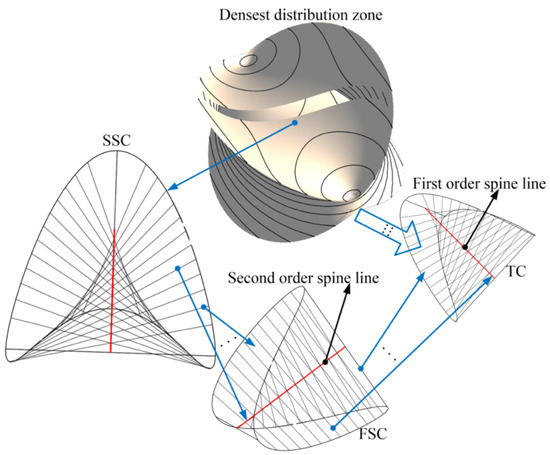
Figure 9.
Decomposition of the densest distribution zone.
The densest distribution zone of the general three-system can be decomposed into TCs, whose spine lines constitute an FSC. There are actually decomposition methods corresponding to FSCs, whose spine lines constitute the SSC. The above decomposition procedure is shown in Figure 9 in detail.
Setting , , and , Figure 10 depicts the relative locations among TCs, FSCs, and SSC in the densest distribution zone of the general three-system.
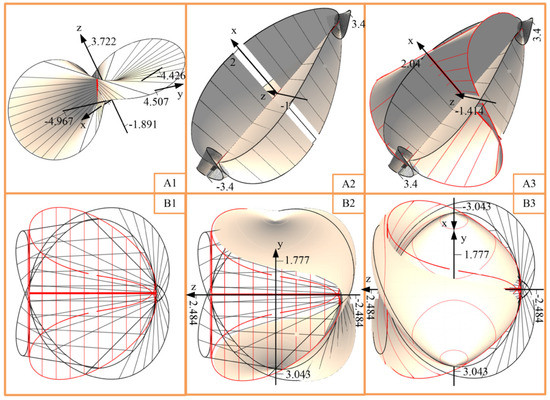
Figure 10.
TCs, FSCs, and SSC, and their boundary surfaces.
Figure 10(A1) shows the TC corresponding to the two-subsystem associated with the line in the plane. The length of the segment lying on the TC represents twice the pitch of the screw passing through the line. Figure 10(A2) shows the FSC corresponding to the family of two-subsystems associated with the family of straight lines in the plane. The segments lying on the FSC are the spine lines of the TCs within the above family of two-subsystems. The spine lines of the two TCs () are coincident with the two end screw axes of the FSC, respectively. Figure 10(A3) shows the SSC (in red curves and lines). The red segments lying on the SSC are the spine lines of the FSCs corresponding to all the families of two-subsystems within the general three-system (, , and ). The spine line of the FSC () is coincident with the principal screw axis of the SSC. Figure 10(B1) shows the SSC (in red curves and lines) and two FSCs () whose spine lines are coincident with the two end screw axes of the SSC, respectively. The three cylindroids are represented by boundary curves and segments lying on the surface. Figure 10(B2,B3) show that the boundary surface of the densest distribution zone completely wraps the three cylindroids shown in Figure 10(B1). So, the proposition in the end of Section 3 is verified again geometrically.
Hunt and Phillips [5,28] presented a distribution characteristic about the central plane of the two-subsystem cylindroid (see Theorem 4). In this section, we try to prove it with a simple computation.
Theorem 4.
Through the origin of the principal frame passes every central plane of TC (including degenerated planar pencils) within a general three-system.
Proof.
Substituting the straight line into Equation (2) leads to the Plücker coordinate of any screw within a two-subsystem, as follows:
When and , the above equation reduces to
Clearly, the pitch of is equal to for any value of . So, the screws represented by Equation (48) belong to the first special two-system. Since these screws lie on a concentric planar pencil, the planar pencil is coincident with the central plane of this two-subsystem. Without a loss of generality, we take two screws as follows:
and then the normal vector of the central plane has the form
In addition, the equation of the central plane [29] has the form
where is the position vector endpoint of . The origin
of the principal frame satisfies the above equation of the central plane. When the screw axes of a two-subsystem lie on a cylindroid, the pitch hi of any screw has the form
Differentiating the above equation with respect to leads to
Setting , we receive the two stationary points
where stands for and , which are associated with the symbol “” and the symbol “” in the symbol “”, respectively. Substituting them into Equation (47) yields the two principal screws and (see the ordinary case of Appendix A). In particular, if k and c make the denominator of equal to zero, then and . For the above three particular cases, three pairs of principal screws are listed in the particular cases of Appendix A. The central plane determined by the above four pairs of principal screws has the form
where the normal vector , is the position vector endpoint of . The origin of the principal frame satisfies the above equation. Therefore, Theorem 4 is proven. □
The above four theorems exactly describe the geometrical regularity of the distribution of all two-subsystems in Euclidean three-space. They will provide exact guides for the axode planning of three degree-of-freedom parallel mechanisms in its reference frame.
5. Varying-Pitch Ruled Surface
The distribution zone of the general three-system can also be decomposed into pitch-hyperboloids. Furthermore, cylindroids and pitch-hyperboloids can be regarded as two particular decomposition methods of the distribution zone of the general three-system. In this section, we will propose a generalized decomposition method: varying-pitch ruled surface based on the pitch-hyperboloid.
It is well known that screws with the same pitch value lie on the same pitch-hyperboloid [4,5]. According to the pitch value, the distribution space of the screw axes within a general three-system can be partitioned into pitch-hyperboloids, two concentric planar pencils, and two coordinate axes of the principal frame. Setting the pitch as a parametric variable, Equation (3) can be rewritten as
When , Equation (56) degenerates into two lines . Considering the proof of Theorem 1, we know that screws with pitch lie on two concentric planar pencils. When , Equation (56) degenerates into the origin of the plane, i.e., the screw with pitch lies on the x-axis of the principal frame. When , Equation (56) does not hold, but the screw with pitch lies on the z-axis.
When , and hold. Equation (56) can be rewritten as the stand equation of the family of ellipses as follows:
Their function expressions have the form
When , and hold. Equation (56) can be rewritten as the stand equation of the family of hyperbolas as follows:
Their function expressions have the form
Setting , , and , the curves represented by Equation (56) are plotted in the plane when the parametric variable takes values in the interval , as shown in Figure 11.
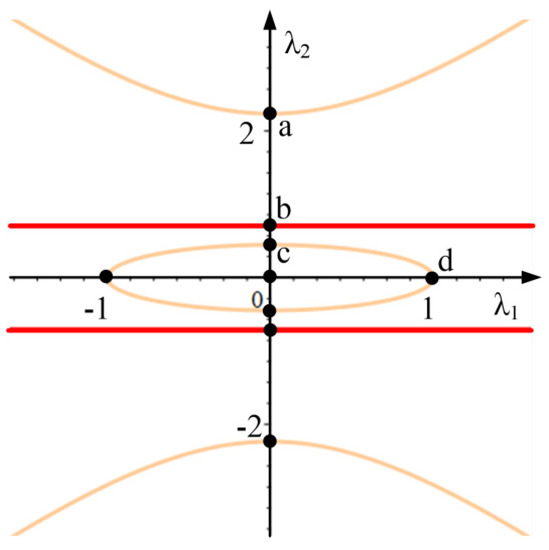
Figure 11.
plane covered by the family of curves.
In Figure 11, the top endpoint a of the major axis of the hyperbola is at . The intersection b of the straight line and the -axis is at . When infinitely approaches , point a infinitely tends to b, and the slope of the asymptotes of the hyperbola infinitely tends to zero. That means the top half of the hyperbola gradually becomes the line . When infinitely approaches , point a infinitely tends to the positive infinity of the -axis. That means the regions above the line and below the line can be completely covered by the family of hyperbolas. The top endpoint c of the ellipse’s minor axis is at . The right endpoint d of the ellipse’s major axis is at . When infinitely approaches , points c and d both infinitely tend to the origin of the plane. When infinitely approaches , point c infinitely tends to point b, and point d infinitely tends to the positive infinity of the -axis. That means the region between the two lines can be completely covered by the family of ellipses. To summarize, the points of the plane can be completely covered by the curves represented by Equation (56) when continuously takes values in the interval .
Substituting Equation (58) and Equation (60) into Equation (20) yields the parametric equation of the striction curve of the ruled surface on which lie screws with the pitches and , respectively, as follows:
where and are associated with the symbol “” and the symbol “” in the symbol “”, respectively, and are associated with the symbol “” and the symbol “” in the symbol “”, respectively.
Setting , , and , when , the corresponding ruled surface, striction curve (in red), and pitch-hyperboloid are as shown in Figure 12A. When , the corresponding ruled surface, striction curve (in red), and pitch-hyperboloid are as shown in Figure 12B.
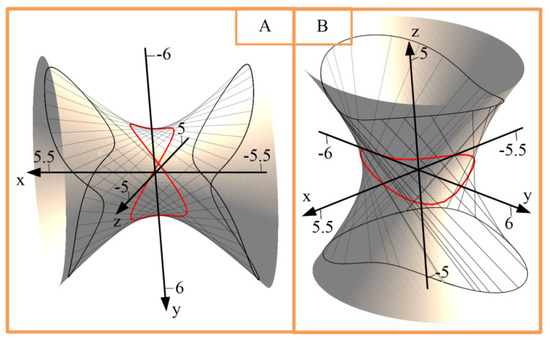
Figure 12.
Ruled surface on a pitch-hyperboloid.
Remark:
Although the ruled surfaces lie on the pitch-hyperboloids, their central ellipses do not cover the striction curves of the ruled surfaces. In the following lines, variation of the parameter in Equation (56) yields the varying-pitch ruled surface.
In particular, if the parametric variable in Equation (56) is substituted by a continuous function of , i.e., , Equation (56) can be rewritten as
Substituting the function expression of Equation (62) into Equation (2) leads to a serial of screws whose pitch value varies according to any desired continuous function . These screws lie on a ruled surface which is defined as the varying-pitch ruled surface. For example, setting , and considering , the function expression of Equation (62) has the form
Setting , and considering , the function expression of Equation (62) has the form
Setting , , and , and substituting Equation (63) and Equation (64) into Equation (2) yield two serials of screws, respectively. Their varying-pitch ruled surfaces and striction curves (in red) are plotted in the Figure 13A and Figure 13B, respectively. The parametric variable c takes the values 3 and 2, as seen in the Figure 13A and Figure 13B, respectively.
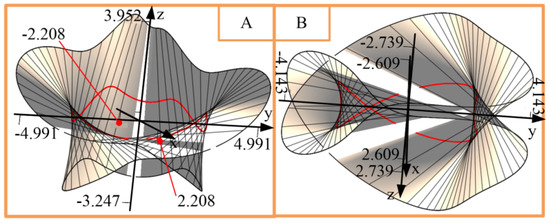
Figure 13.
Varying-pitch ruled surface.
6. Numerical Examples of the 3-RPS Pyramid Mechanism
In axode planning, there is a basic problem: given an axode arbitrarily in the reference frame of a parallel mechanism, how can one visually tell whether this axode can be produced by the mechanism when it passes through a serial of configurations? The necessary condition is that its striction curve is inside the zone consisting of a serial of densest distribution zones associated with a serial of configurations, respectively.
Huang [30] pointed out that the twist screw system of the 3-RPS pyramid mechanism is just a general three-system of screws. So, in this section, we present a numerical example of a 3-RPS pyramid mechanism to demonstrate that the necessary conduction is valid. The mechanism consists of a base , a moving platform , and three identical-limb RPSs. Here, R represents the revolute joint, P denotes the prismatic joint, and S stands for the spherical joint. In particular, the axis of the R joint is perpendicular to that of the P joint. The reference frame attached to the base has its origin located at the point and its three axes are along the three ones of the R joints of the base, respectively. The body frame attached to the moving platform has its origin located at the midpoint of the triangle , its z-axis perpendicular to the plane , its y-axis parallel to the segment and in the plane , and its x-axis defined according to the right-hand rule as shown in Figure 14. In the configuration shown in Figure 14, the lengths of three P joints are M, and the mechanism takes on the form of a cube.
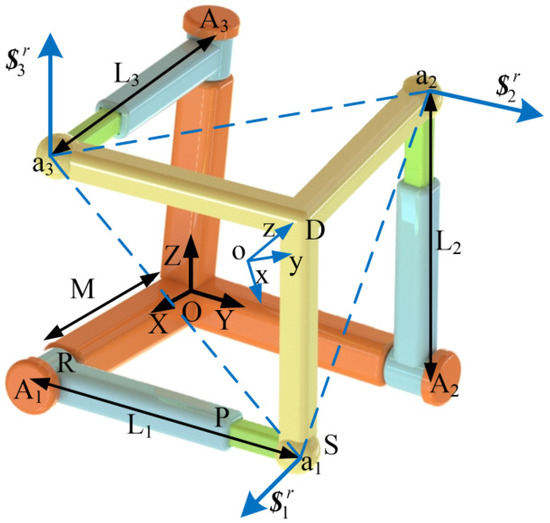
Figure 14.
The structure and constraint wrench screws of a 3-RPS pyramid mechanism.
Limb i imposes a constraint wrench screw on the moving platform. They pass through the three centers of the S joints and are parallel to the three axes of three R joints, respectively. So, they are linearly independent and constrain three translational freedoms of this mechanism, whatever configuration it is under. The reciprocal screw system of the above three constraint wrench screws is a general three-system of screws and stands for three rotational freedoms of the mechanism. The 3-RPS pyramid mechanism sets its structural parameters and input parameters as follows:
where represents the initial orientation of the body frame with respect to the reference frame. M is the length of the segment . , and are the input parameters of the three P joints, respectively, when the mechanism performs a motion task. In this motion task, a serial of densest distribution zones and an axode can be obtained as shown in Figure 15. The Figure 15(A1–A3) display the densest distribution zones from three different views, respectively. The striction curve (in blue) of the axode is shown in the Figure 15(B1–B3) from three different views, respectively. As shown in Figure 15, the striction curve indeed is located inside the zone consisting of a serial of densest distribution zones.
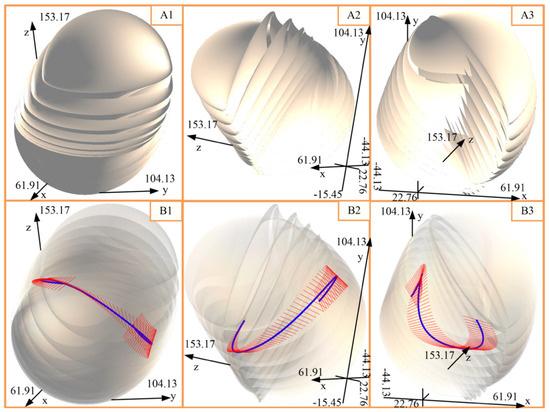
Figure 15.
The striction curve of an axode and the densest distribution zones.
7. Discussions
Section 4 partitions the general three-system according to the family of straight lines in the plane, while Section 5 partitions it according to the family of ellipses and the family of hyperbolas. In particular, the varying-pitch ruled surface associated with the desired continuous function corresponds to more general curves in the plane. So, the varying-pitch ruled surface is a generalized decomposition method. In the first two decomposition methods, the family of lines and the family of ellipses and hyperbolas both completely cover the points in the plane.
8. Conclusions
This paper has addressed the distribution regularity of the screw axes of the general three-system. The main achieved findings are that the position vector endpoints of the screw axes lie on the surface . Further, these screw axes most densely distribute in the densest distribution zone bounded by two end striction point surfaces. Furthermore, the densest distribution zone of screw axes of the general three-system can be decomposed into two-subsystem cylindroids whose spine lines lie on a certain first-order spine cylindroid.
Author Contributions
Conceptualization, Y.Z. and L.Z.; methodology, L.Z.; formal analysis, L.Z.; writing—original draft preparation, L.Z.; writing—review and editing, Y.Z.; visualization, L.Z. and X.W. All authors have read and agreed to the published version of the manuscript.
Funding
This research was funded by the Natural Science Foundation Key projects of Hebei Province (grant number E2021203125), and the Local science and technology development fund projects guided by the central government (grant number 206Z1807G).
Institutional Review Board Statement
Not applicable.
Informed Consent Statement
Not applicable.
Data Availability Statement
Not applicable.
Conflicts of Interest
The authors declare no conflict of interest.
Appendix A
The ordinary case of the proof of Theorem 4:
Three particular cases of the proof of Theorem 4:
References
- Huang, Z.; Tao, W.S.; Fang, Y.F. Study on the kinematic characteristics of 3 DOF in-parallel actuated platform mechanisms. Mech. Mach. Theory 1996, 31, 999–1007. [Google Scholar] [CrossRef]
- Chen, G.L.; Wang, H.; Lin, Z.Q.; Lai, X.M. Identification of canonical basis of screw systems using general-special decomposition. J. Mech. Robot. 2018, 10, 034501. [Google Scholar] [CrossRef]
- Ball, R.S. A Treatise on the Theory of Screws; Cambridge University Press: Cambridge, UK, 1998. [Google Scholar]
- Hunt, K.H. Kinematic Geometry of Mechanisms; Oxford University Press: Oxford, UK, 1978. [Google Scholar]
- Phillips, J. Freedom in Machinery; Cambridge University Press: Cambridge, UK, 2007. [Google Scholar]
- Zlatanov, D. The representation of the general three-system of screws by a sphere. Mech. Mach. Theory 2012, 49, 315–331. [Google Scholar] [CrossRef]
- Huang, Z.; Li, Q.C.; Ding, H.F. Theory of Parallel Mechanisms; Springer: Dordrecht, The Netherlands, 2013. [Google Scholar]
- Parkin, J.A. Co-ordinate transformations of screws with applications to screw systems and finite twists. Mech. Mach. Theory 1990, 25, 689–699. [Google Scholar] [CrossRef]
- Tsai, M.J.; Lee, H.W. On the special bases of two- and three-screw systems. J. Mech. Des. 1993, 115, 540–546. [Google Scholar] [CrossRef]
- Parkin, I.A. Finding the principal axes of screw systems. In Proceedings of the ASME 1997 Design Engineering Technical Conferences, Sacramento, CA, USA, 14–17 September 1997; pp. 1–9. [Google Scholar]
- Rico, J.M.; Duffy, J. A general method for the computation of the canonical form of three-systems of infinitesimal screws. Robotica 1998, 16, 37–45. [Google Scholar] [CrossRef]
- Bandyopadhyay, S.; Ghosal, A. Analytical determination of principal twists in serial, parallel and hybrid manipulators using dual vectors and matrices. Mech. Mach. Theory 2004, 39, 1289–1305. [Google Scholar] [CrossRef]
- Bandyopadhyay, S.; Ghosal, A. An eigenproblem approach to classical screw theory. Mech. Mach. Theory 2009, 44, 1256–1269. [Google Scholar] [CrossRef] [Green Version]
- Zhao, J.S.; Zhou, H.X.; Feng, Z.J.; Dai, J.S. An algebraic methodology to identify the principal screws and pitches of screw systems. Proc. Inst. Mech. Eng. Part C J. Mech. Eng. Sci. 2009, 223, 1931–1941. [Google Scholar] [CrossRef]
- Zhang, W.X.; Xu, Z.C. Algebraic construction of the three-system of screws. Mech. Mach. Theory 1998, 33, 925–930. [Google Scholar] [CrossRef]
- Fang, Y.F.; Huang, Z. Analytical identification of the principal screws of the third order screw system. Mech. Mach. Theory 1998, 33, 987–992. [Google Scholar] [CrossRef]
- Huang, C.; Sugimoto, K.; Parkin, I. The correspondence between finite screw systems and projective spaces. Mech. Mach. Theory 2008, 43, 50–56. [Google Scholar] [CrossRef]
- Hathout, F.; Bekar, M.; Yayli, Y. Ruled surfaces and tangent bundle of unit 2-sphere. Int. J. Geom. Methods Mod. Phys. 2017, 14, 1750145. [Google Scholar] [CrossRef]
- Zhang, L.L.; Zhao, Y.Z.; Ren, J.K. Screw rolling between moving and fixed axodes traced by lower-mobility parallel mechanism. Mech. Mach. Theory 2021, 163, 104354. [Google Scholar] [CrossRef]
- Zhang, L.L.; Zhao, Y.Z.; Zhao, T.S. Fundamental equation of mechanism kinematic geometry: Mapping curve in se(3) to counterpart in SE(3). Mech. Mach. Theory 2020, 146, 103732. [Google Scholar] [CrossRef]
- Toscano, G.S.; Simas, H.; Castelan, E.B.; Martins, D. A new kinetostatic model for humanoid robots using screw theory. Robotica 2018, 36, 570–587. [Google Scholar] [CrossRef]
- Zhao, T.; Geng, M.; Chen, Y.; Li, E.; Yang, J. Kinematics and dynamics Hessian matrices of manipulators based on screw theory. Chin. J. Mech. Eng. 2015, 28, 226–235. [Google Scholar] [CrossRef]
- Sharafian, M.E.; Taghvaeipour, A.; Ghassabzadeh, S.M. Revisiting screw theory-based approaches in the constraint wrench analysis of robotic systems. Robotica 2021, 1–25. [Google Scholar] [CrossRef]
- Gallardo-Alvarado, J.; Aguilar-Nájera, C.R.; Casique-Rosas, L.; Rico-Martínez, J.M.; Islam, M.N. Kinematics and dynamics of 2(3-RPS) manipulators by means of screw theory and the principle of virtual work. Mech. Mach. Theory 2008, 43, 1281–1294. [Google Scholar] [CrossRef]
- Fan, S.; Fan, S. An improved approach to the inverse dynamic analysis of parallel manipulators by a given virtual screw. Adv. Robot. 2018, 32, 887–902. [Google Scholar] [CrossRef]
- Bu, W. Closeness to singularities of manipulators based on geometric average normalized volume spanned by weighted screws. Robotica 2016, 35, 1616–1626. [Google Scholar] [CrossRef]
- Gallardo-Alvarado, J.; Abedinnasab, M.H.; Islam, M.N. A Simple Method to Solve the Instantaneous Kinematics of the 5-RPUR Parallel Manipulator. Robotica 2019, 37, 1143–1157. [Google Scholar] [CrossRef]
- Hunt, K.H.; McAree, P.R. Some new surfaces within the general three-system of screws. Mech. Mach. Theory 1994, 29, 981–994. [Google Scholar] [CrossRef]
- Huang, Z.; Zhao, Y.S.; Zhao, T.S. Advanced Spatial Mechanism, 2nd ed.; Higher Education Press: Beijing, China, 2014. [Google Scholar]
- Huang, Z.; Fang, Y.F. Kinematic characteristics analysis of 3 DOF in-parallel actuated pyramid mechanism. Mech. Mach. Theory 1996, 31, 1009–1018. [Google Scholar] [CrossRef]
Publisher’s Note: MDPI stays neutral with regard to jurisdictional claims in published maps and institutional affiliations. |
© 2022 by the authors. Licensee MDPI, Basel, Switzerland. This article is an open access article distributed under the terms and conditions of the Creative Commons Attribution (CC BY) license (https://creativecommons.org/licenses/by/4.0/).